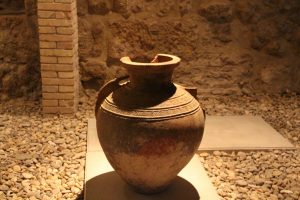October 2nd
I am going to have to borrow Abby’s thesaurus. I believe I have run out of superlatives for this trip.
Yesterday’s post closed with a mention that we were going to attend a Flamenco Bienal performance. It was at the Lope de Vega Theater near the Maria Louisa gardens. We got there early and sat outside with a little drink before going into this well-restored 1929 venue. We were up on the 4th floor, but our seats gave us a very good view of the Una Toda Vida (“A Lifetime”) show. For nearly 3 hours we listened, watched, and cheered as a group of long-time Flamenco performers completely captivated us.
We didn’t get back until after midnight which made this morning’s departure at 7:00 a little bit of a challenge. It was still dark when we left for the Santa Justa station. [Santa Justa and her sister, Santa Rufina, are often shown protecting the La Giralda, which represents the city. They lived in the 3rd century.] Our trip to Córdoba took only 45 minutes. We had a small breakfast while waiting for our tour to begin. It is probably redundant to say “small” because breakfast does not seem to be an important meal at all.
Our guide, Jose, spent 3 hours and 15 minutes introducing us to the 3 cultures of Córdoba; Muslim, Jewish, and Christian. He is an archeologist and very knowledgeable. We had signed up for a group trip, but it turned out that Patricia and I were the group. Jose was willing to answer any question we asked and we had a good exchange with him.
It is a good thing we had a guide because there are probably people who tried to navigate the labyrinth of streets without a guide who will never be heard from again.
We saw and heard about the evolution of the city and its environs from pre-historic times through the Romans, Visigoths, Muslims, Jews, and Christians. Córdoba is located in a strategic position along what is now the Guadalquivir River. When we climbed one of the towers it was easy to visualize the value of the city’s location. I’ll write more about the Mezquita (the Mosque – Cathedral) later, but just as that space was reused/repurposed many times, so too with other parts of the city. We learned about the style of houses and shops and how one culture influenced others over time—sometimes over a fairly short time. We learned about the impacts of religious and economic wars and how the results of those can still be seen today.
Jose took us to one setting after another that had historical / cultural / archeological significance. I’ll let you see some of them in the pictures. In churches, for example, you could see the Muslim influence in the decorations. We visited both Muslim and Christian baths and we could see that the later had clear copies of some of the former’s features. We walked through Queen Isabella’s gardens which had elements very similar to Muslim gardens: beautiful, formal, paths and plants, water features using Muslim technologies, and so on.
In one room in the Alcázar, now used for daily civic functions, we saw an outstanding collection of mosaics lining the walls of this large chamber. We climbed into some of the towers that protected the area and we saw graffiti from prisoners of the Inquisition (another thing religion has to answer for) that was similar to graffiti I saw in the Tower of London and probably like what I would see if I visited the Chateau d’If (Count of Monte Christo) off the south of France.
I won’t try to tell you everything we saw and learned because that would not be practical. I will say that I expect it will take us some time to absorb all of it.
We had to rush from the Alcázar back to the Mezquita for our afternoon tour of the Mosque-Cathedral–which from here I will call the Cathedral. This time we were in a mixed group of French and English speakers. The guide would talk for a while in one language and then switch to the other. In contrast to the morning, we had little interaction with our guide.
At this site, the church was originally built by the Visigoths, but before that it was a Roman temple dedicated to Janus and who knows what it was before that. When the Muslims defeated the Visigoths in Córdoba the church was shared, for a while, between Christians and Muslims.
When al Rahman I came to Córdoba in the mid-750s, he wanted to build a mosque that would reflect the glory of his reign and rival those in Baghdad, Jerusalem, and Damascus. The first version of the mosque took nearly 200 years to complete but it has been expanded ever since first by successive Muslim dynasties and then by Christians (after around 1485).
Inside the Cathedral our guide was careful to show us the various architectural styles. I would have been able to see some, but not all, of the style differences on my own so I am glad we went with a group.
The history part of the tour was useful but the real impact of the Cathedral is visual. It is nothing short of stunning. Now that it is a church it is a little dark but before that it must have been even more impressive in terms of light. The interior is huge. It used to be the 3rd largest mosque in the world—it is now 7th or 8th. There are nearly 900 marble columns inside (wait until you see the pictures). The combined Muslim and Christian interior makes the building unique. It can hold more than 14,000 people. The many tour groups inside made hardly a dent in the space.
The huge spaces and rows of columns, the decorated ceilings, the side chapels, the impressive altars and the chorus took our breath away. Stuck in the back of my mind was the enormous amount of treasure and work that went into building the mosque-cathedral, but at the same time one must admire the impulses to create beauty which, like this, has lasted more the 1200 years. We spent less than 2 hours inside and by the time we were done, we very tired. One architectural triumph after another had somewhat numbed us.
At this point in our trip Patricia is already thinking we will have to come back: there is just too much to see and learn for one visit.
More pictures on the pictures page.




